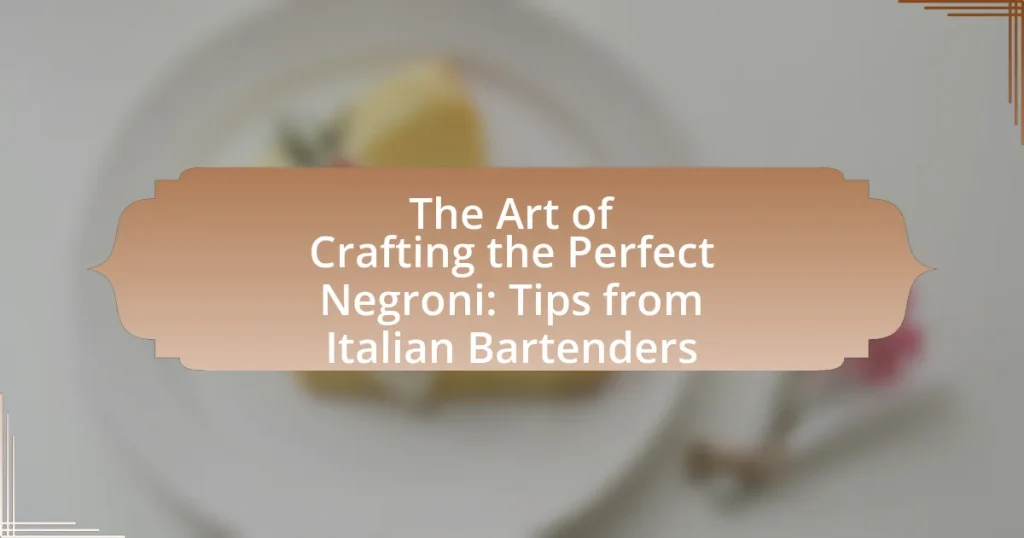The Negroni is a classic Italian cocktail composed of equal parts gin, vermouth rosso, and Campari, garnished with an orange peel. Its origins trace back to 1919 in Florence, Italy, where Count Camillo Negroni requested a stronger version of the Americano cocktail, leading to its creation. This article explores the historical significance of the Negroni, the key figures involved in its development, and the cultural influences that shaped its evolution. It also provides insights into the essential ingredients, mixing techniques, and best practices for crafting the perfect Negroni, emphasizing the importance of quality ingredients and precise measurements in achieving a balanced flavor profile.

What is the Negroni and its Historical Significance?
The Negroni is a classic Italian cocktail made from equal parts gin, vermouth rosso, and Campari, garnished with an orange peel. Its historical significance dates back to the early 20th century, specifically around 1919, when Count Camillo Negroni is credited with its creation in Florence, Italy, by requesting a stronger version of the Americano cocktail. This drink has since become a symbol of Italian aperitivo culture and is celebrated for its balance of bitter and sweet flavors, influencing cocktail culture worldwide.
How did the Negroni originate?
The Negroni originated in Florence, Italy, in the early 20th century. It was created when Count Camillo Negroni requested a stronger version of the Americano cocktail, substituting gin for soda water. This modification led to the iconic blend of gin, vermouth, and Campari, which became known as the Negroni. The drink was first served at Caffè Casoni, where it gained popularity and has since become a classic cocktail worldwide.
Who are the key figures in the creation of the Negroni?
The key figures in the creation of the Negroni are Count Camillo Negroni and bartender Fosco Scarselli. Count Negroni, an Italian nobleman, is credited with inventing the cocktail in Florence around 1919 by asking Scarselli to strengthen his favorite drink, the Americano, by substituting gin for soda water. This pivotal request led to the creation of the Negroni, which has since become a classic cocktail. The historical context of this invention highlights the influence of Italian culture on cocktail crafting, particularly in the early 20th century.
What cultural influences shaped the Negroni’s development?
The Negroni’s development was shaped primarily by Italian culture, particularly the tradition of aperitivo, which emphasizes socializing before meals with cocktails. This cultural practice, rooted in Italy’s culinary heritage, encouraged the creation of balanced drinks that stimulate the appetite. The Negroni itself emerged in Florence in the early 20th century, attributed to Count Camillo Negroni, who requested a stronger version of the Americano cocktail by substituting gin for soda water. This adaptation reflects the Italian penchant for innovation within established culinary frameworks. The drink’s popularity further spread through Italy’s vibrant bar scene, where local ingredients and regional variations contributed to its evolution, solidifying its status as a classic Italian cocktail.
What are the essential ingredients of a Negroni?
The essential ingredients of a Negroni are equal parts gin, Campari, and sweet vermouth. This classic Italian cocktail is traditionally served over ice and garnished with an orange slice. The balance of these three ingredients creates a distinctive bitter and aromatic flavor profile, which is a hallmark of the Negroni.
What role does gin play in the Negroni?
Gin serves as the primary spirit in a Negroni, providing the cocktail with its distinctive botanical flavors. The choice of gin influences the overall taste profile, as different gins offer varying notes of herbs, spices, and citrus. Traditionally, a classic London Dry gin is used, which complements the bitter notes of Campari and the sweetness of vermouth, creating a balanced and complex drink. The role of gin is essential, as it not only contributes to the cocktail’s flavor but also its character, making it a foundational element in the Negroni’s composition.
How do vermouth and Campari contribute to the flavor profile?
Vermouth and Campari significantly enhance the flavor profile of a Negroni by adding complexity and balance. Vermouth, a fortified wine infused with various botanicals, contributes herbal and sweet notes, which counterbalance the bitterness of Campari. Campari, known for its distinct bitter flavor derived from a blend of herbs, fruits, and spices, introduces a vibrant and aromatic bitterness that is essential to the cocktail’s character. Together, these ingredients create a harmonious blend of sweet, bitter, and herbal flavors, making the Negroni a well-rounded and sophisticated drink.

What Techniques Do Italian Bartenders Use to Craft the Perfect Negroni?
Italian bartenders use precise techniques to craft the perfect Negroni, including the use of high-quality ingredients, proper measuring, and meticulous stirring. They typically select equal parts of gin, Campari, and sweet vermouth, ensuring that each component is fresh and well-balanced. Bartenders often chill the glass beforehand and use a mixing glass with ice to stir the ingredients gently for about 30 seconds, which dilutes the drink just enough to enhance its flavors without watering it down. The final touch involves straining the mixture into a chilled glass and garnishing it with a twist of orange peel, which adds aromatic oils that elevate the cocktail’s profile. These methods reflect a commitment to quality and tradition, essential in Italian cocktail culture.
How do bartenders select the right ingredients?
Bartenders select the right ingredients by considering flavor profiles, quality, and balance. They analyze the characteristics of each component, such as the bitterness of Campari, the sweetness of vermouth, and the aromatic qualities of gin, to ensure they complement each other in a Negroni. Additionally, bartenders often prioritize fresh, high-quality ingredients, as evidenced by the use of artisanal spirits and fresh citrus, which enhance the overall taste and presentation of the cocktail.
What factors influence the choice of gin and vermouth?
The choice of gin and vermouth is influenced by flavor profiles, quality, and personal preferences. Different gins offer varying botanical flavors, which can enhance or complement the bitterness of vermouth. For instance, a London Dry gin typically has a more pronounced juniper flavor, while a floral gin may provide a lighter, aromatic experience. The quality of vermouth also plays a crucial role; premium vermouths often have complex flavors that can elevate the overall cocktail. Additionally, personal taste preferences, such as sweetness or bitterness levels, significantly affect the selection process. Bartenders often recommend experimenting with different combinations to find the ideal balance for a Negroni, reflecting the drinker’s unique palate.
How does the quality of ingredients affect the final drink?
The quality of ingredients directly influences the flavor, aroma, and overall experience of the final drink. High-quality ingredients, such as premium spirits and fresh botanicals, enhance the complexity and balance of flavors in a Negroni, resulting in a more enjoyable and refined cocktail. For instance, using a well-crafted gin with distinct botanical notes can elevate the drink’s profile, while inferior spirits may lead to a flat or harsh taste. Additionally, fresh ingredients, like citrus, contribute vibrant flavors that are essential for a balanced Negroni. Studies have shown that the sensory attributes of cocktails are significantly affected by ingredient quality, underscoring the importance of selecting superior components for optimal results.
What mixing techniques are recommended for a Negroni?
To craft a Negroni effectively, the recommended mixing techniques include stirring and proper ingredient ratios. Stirring the ingredients—equal parts gin, Campari, and sweet vermouth—over ice in a mixing glass ensures a well-chilled and diluted cocktail, which is essential for balancing the strong flavors. Italian bartenders emphasize the importance of using fresh ice and a bar spoon for stirring, as this technique allows for a smoother texture and enhances the drink’s overall flavor profile.
How does stirring differ from shaking in cocktail preparation?
Stirring differs from shaking in cocktail preparation primarily in the method of mixing and the resulting texture of the drink. Stirring involves gently combining ingredients with a bar spoon in a mixing glass, which maintains the clarity and smoothness of the cocktail, while shaking involves vigorously mixing ingredients in a shaker, incorporating air and creating a frothy texture. This distinction is crucial for cocktails like the Negroni, where a smooth, well-integrated drink is desired, as shaking can dilute and alter the intended flavor profile.
What is the importance of ice in crafting a Negroni?
Ice is crucial in crafting a Negroni as it regulates the drink’s temperature and dilutes the ingredients to achieve the desired balance of flavors. The chilling effect of ice enhances the aromatic qualities of the gin, vermouth, and Campari, while the gradual dilution allows the drink to evolve in taste as it is consumed. Properly sized ice cubes, ideally large and slow-melting, minimize excessive dilution, ensuring that the drink maintains its integrity and flavor profile throughout the drinking experience.

What Tips Can Enhance Your Negroni Experience?
To enhance your Negroni experience, use high-quality ingredients, including premium gin, vermouth, and Campari. The choice of ingredients significantly impacts the flavor profile; for instance, using a craft gin can introduce unique botanicals that elevate the drink. Additionally, experiment with different vermouths, as their sweetness and herbal notes can vary widely, influencing the overall taste.
Serving the Negroni over a large ice cube instead of smaller ones slows dilution, maintaining the drink’s integrity longer. Garnishing with a fresh orange peel, rather than a twist, releases essential oils that enhance aroma and flavor. Finally, consider chilling your glass beforehand to keep the drink colder for an extended period, further improving the overall experience.
How can you customize your Negroni to suit your taste?
You can customize your Negroni by adjusting the proportions of gin, vermouth, and Campari to match your flavor preferences. For example, if you prefer a sweeter drink, increase the amount of vermouth; if you enjoy a more bitter profile, add more Campari. Additionally, experimenting with different types of gin, such as a floral or citrus-forward variety, can significantly alter the drink’s character. Infusing your gin with herbs or spices can also provide a unique twist. According to Italian bartenders, using high-quality ingredients and fresh garnishes, like an orange twist or a sprig of rosemary, enhances the overall experience and allows for personal expression in crafting the perfect Negroni.
What variations exist for the classic Negroni recipe?
Variations for the classic Negroni recipe include the Negroni Sbagliato, which substitutes prosecco for gin, and the White Negroni, which uses Lillet Blanc and Suze instead of traditional ingredients. Other notable variations are the Boulevardier, which replaces gin with bourbon or rye whiskey, and the Negroni Bianco, featuring white vermouth and a lighter flavor profile. Each variation maintains the core concept of equal parts spirit, but introduces unique flavors and characteristics, showcasing the versatility of the original recipe.
How can garnishes elevate the presentation and flavor?
Garnishes can elevate the presentation and flavor of a Negroni by adding visual appeal and enhancing taste complexity. For instance, a twist of orange peel not only provides a vibrant color contrast but also releases essential oils that complement the bitter notes of Campari, enriching the overall flavor profile. Additionally, using fresh herbs like basil or mint can introduce aromatic elements that enhance the drinking experience. Studies in culinary arts show that visual presentation significantly influences perceived taste, indicating that well-chosen garnishes can make a cocktail more enjoyable both visually and sensorially.
What common mistakes should you avoid when making a Negroni?
Common mistakes to avoid when making a Negroni include using poor-quality ingredients, not balancing the proportions correctly, and neglecting to chill the glass. Using low-quality gin, vermouth, or Campari can significantly affect the cocktail’s flavor, as the Negroni relies on the quality of its components for a harmonious taste. The traditional ratio of one part gin, one part vermouth, and one part Campari must be adhered to for optimal balance; deviating from this can lead to an unbalanced drink. Additionally, serving the Negroni in a warm glass can dilute the flavors, so chilling the glass beforehand is essential for maintaining the cocktail’s integrity.
How can improper ingredient ratios affect the drink?
Improper ingredient ratios can significantly alter the flavor profile and overall balance of a drink, such as a Negroni. For instance, using too much vermouth can overpower the bitterness of the Campari, leading to a cloyingly sweet taste, while insufficient gin can result in a lack of complexity and depth. This imbalance can detract from the intended experience of the drink, which is meant to harmonize the bitter, sweet, and herbal notes. Studies in mixology emphasize that precise measurements are crucial for achieving the desired taste and aroma, as even slight deviations can lead to a subpar cocktail experience.
What are the signs of a poorly crafted Negroni?
A poorly crafted Negroni typically exhibits an imbalance in flavor, often resulting from incorrect ratios of gin, vermouth, and Campari. This imbalance can manifest as an overly bitter taste, insufficient sweetness, or a lack of complexity. Additionally, signs include the use of low-quality ingredients, which can lead to a flat or unappealing flavor profile, and improper dilution, where the drink is either too watered down or overly strong. The absence of a proper garnish, such as an orange twist, can also detract from the overall presentation and aroma, further indicating a lack of attention to detail in the cocktail’s preparation.
What are the best practices for serving and enjoying a Negroni?
The best practices for serving and enjoying a Negroni include using equal parts of gin, Campari, and sweet vermouth, served over ice in a short glass. This classic cocktail should be stirred gently to combine the ingredients without diluting them excessively. A twist of orange peel as a garnish enhances the aroma and flavor profile, aligning with traditional Italian bartending techniques. The Negroni is best enjoyed chilled, allowing the balance of bitterness and sweetness to shine, which is a hallmark of its Italian heritage.










